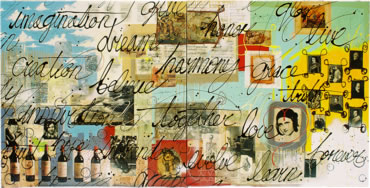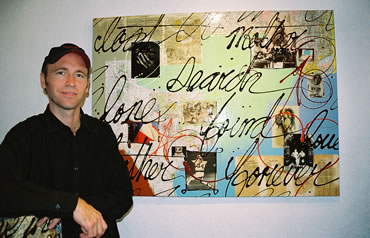Inspirational Abstraction

Retrospect
I first assumed that abstract art was made by drunks, fakes, and madmen. But the more I read into it, the more I began to understand. Most of them were just being “American.” You see, before most of the abstract artists (or New York School) got their start, all the great modern art in the world came from Europe. Our country was looking for its own identity in the art-world, and was able to find one through a collection of men who were out of work, who wanted to “out-paint” Picasso, and who just happened to be drunks.
Most of the discoveries they made on canvas were “accidents” at first, but in time they became masters at creating, and recreating, the same accidents. In Pollock’s case, he pioneered the use of “Automatism” (or Automatic Painting) — a physical process in which his subconscious guides his hand, free from self-will and control. The result was evidence of grand strokes of confidence, independence, and enamel paint.
 But of course the paintings were misunderstood. What did they mean? Mostly that
the painter, and certainly the buyer, of the work were insane. Today the paintings are
some of the most valuable ever made. And more insanity followed. Willem DeKooning “Excavated” a
new style of painting and butchered his female forms. Franz Kline painted his architectural
giants with a broom! Robert Rauschenberg erased a DeKooning pencil drawing to make a point. But
what is the point? Can Abstract Art have meaning? Most people look for meaning in
paintings. I do.
But of course the paintings were misunderstood. What did they mean? Mostly that
the painter, and certainly the buyer, of the work were insane. Today the paintings are
some of the most valuable ever made. And more insanity followed. Willem DeKooning “Excavated” a
new style of painting and butchered his female forms. Franz Kline painted his architectural
giants with a broom! Robert Rauschenberg erased a DeKooning pencil drawing to make a point. But
what is the point? Can Abstract Art have meaning? Most people look for meaning in
paintings. I do.
I tried my best to recreate the great dripped paintings I admired, but the harder I tried the bigger mess I made. I thought if I only drank enough, certainly I could make at least one great abstract painting. In fact, I did.
One fateful night I took a painting (of clouds) that was given to me by an unrequited love, and set out to destroy it by dripping the names of the offenders of our love upon it. I covered the blue sky with thick globs of black enamel, and then I passed out. When I awoke, the painting was lying on the floor like a stranger. When I had the presence of mind to place the painting on the lighted easel, I was shocked. It made perfect sense. It had meaning. And what’s more, the heartache of the night before was before me in a frozen message — to remind me, to inspire me.
Since then, my “accident” has evolved into a technique that I hope gives me a signature style and honors the forefathers of modern art that inspired me. I think we all need inspiration. We all want to look at something beautiful, but also see that which makes us feel something beautiful.
 I use colors, images, and words that have impact. What can be more abstract than a word?
Take the word “God.” Need I say more? Every human being knows the word well,
but each of us has a completely different concept of what it is. And what about “Love?” We
all know what it is, but don’t have the ability to explain it. Words are important
to us, but their abstract meanings exist just beyond the tips of our tongues.
I use colors, images, and words that have impact. What can be more abstract than a word?
Take the word “God.” Need I say more? Every human being knows the word well,
but each of us has a completely different concept of what it is. And what about “Love?” We
all know what it is, but don’t have the ability to explain it. Words are important
to us, but their abstract meanings exist just beyond the tips of our tongues.
And last a word about inspiration. In today’s world we see the “writing on the wall” all too well. So many times the messages that fill our lives are nothing more than warnings, advertisements, or angry graffiti. These days it seems easier to say something negative. I feel that we can benefit from words that heal, stimulate, motivate, or at least make us think. I would never use a canvas and waste paint to convey anything other than beauty or hope. I need to see it, I need to say it. I hope the paintings can have a conversation with the viewer. Whether just on the surface, or deep in the subconscious, the words in paint have a meaning more than just that of the author. Whether a poem, a sonnet, a song, or a prayer, I hope they speak to the soul.
I invite you to interpret and celebrate the words today, and for years to come.
God Bless,
Robert Ellis Patterson